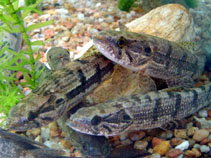Hoplias malabaricus (Bloch, 1794)
Trahira
Envoyez vos Photos et vidéos
Pictures | Images GoogleHoplias malabaricus
Picture by Roselet, F.F.G.
Pictures | Images GoogleHoplias malabaricus
Picture by Roselet, F.F.G.
Argentina country information
Common names:
Dientudo, Jerũ-perro, Lobó
Occurrence: native
Salinity: freshwater
Abundance: | Ref:
Importance: | Ref:
Aquaculture: | Ref:
Regulations: | Ref:
Uses: no uses
Comments: Known from Diamante in the Lower Paraná River (Ref. 11229). Also Ref. 6029.
National Checklist: Argentina
Country Information: https://www.cia.gov/library/publications/resources/the-world-factbook/geos/ar.html
National Fisheries Authority:
Occurrences: Occurrences Point map
Main Ref: López, H.L., A.M. Miquelarena and J. Ponte Gómez, 2005
National Database:
Occurrence: native
Salinity: freshwater
Abundance: | Ref:
Importance: | Ref:
Aquaculture: | Ref:
Regulations: | Ref:
Uses: no uses
Comments: Known from Diamante in the Lower Paraná River (Ref. 11229). Also Ref. 6029.
National Checklist: Argentina
Country Information: https://www.cia.gov/library/publications/resources/the-world-factbook/geos/ar.html
National Fisheries Authority:
Occurrences: Occurrences Point map
Main Ref: López, H.L., A.M. Miquelarena and J. Ponte Gómez, 2005
National Database:
Common names from other countries
Classification / Names Noms communs | Synonymes | Catalog of Fishes(Genre, Espèce) | ITIS | CoL | WoRMS | Cloffa
> Characiformes (Characins) > Erythrinidae (Trahiras)
Etymology: Hoplias: Greek, hoplon = weapon (Ref. 45335).
More on author: Bloch.
Etymology: Hoplias: Greek, hoplon = weapon (Ref. 45335).
More on author: Bloch.
Environment: milieu / climate zone / depth range / distribution range Écologie
; eau douce benthopélagique; pH range: 6.0 - 8.0; dH range: 4 - 25; potamodrome (Ref. 51243). Tropical; 20°C - 26°C (Ref. 2060); 11°N - 35°S, 85°W - 35°W
Distribution Pays | Zones FAO | Écosystèmes | Occurrences | Point map | Introductions | Faunafri
Central and South America: Costa Rica to Argentina in most rivers basins.
Length at first maturity / Taille / Poids / Âge
Maturity: Lm ?, range 17 - ? cm
Max length : 65.0 cm TL mâle / non sexé; (Ref. 111518); poids max. publié: 3.8 kg (Ref. 111518)
Max length : 65.0 cm TL mâle / non sexé; (Ref. 111518); poids max. publié: 3.8 kg (Ref. 111518)
Occurs in diverse habitats from free flowing clear water streams, well up into the valleys, to slow turbid waters, water courses, irrigation and drainage ditches, and ponds on the plains (Ref. 11225). Rests in vegetation during the day and is active at night (Ref. 6858). Adults feed on fish; juveniles feed on crustacean and insect larvae (Ref. 26543), shrimps and other small invertebrates (Ref. 12225). Spawn in pits located in shallow water at a temperature of about 26°C (Ref. 205). Males guard the nests even after the eggs have hatched (Ref. 205). Reaches more than 3 kg (Mark Fitzgerald, pers. comm., 2001). Live fish are difficult to handle and potentially dangerous because of their sharp teeth, strong jaws, and slippery bodies.
Life cycle and mating behavior Maturité | Reproduction | Frai | Œufs | Fécondité | Larves
Eggs are fertilized in the cupped anal fin of the female. When the eggs get sticky, they are dropped into a pit which will be guarded by the male even until after the eggs have hatched (Ref. 205).
Référence principale
Upload your references | Références | Coordinateur : Oyakawa, Osvaldo T. | Collaborateurs
Planquette, P., P. Keith and P.-Y. Le Bail, 1996. Atlas des poissons d'eau douce de Guyane. Tome 1. Collection du Patrimoine Naturel Volume 22, MNHN, Paris & INRA, Paris. 429 p. (Ref. 12225)
Statut dans la liste rouge de l'IUCN (Ref. 130435: Version 2024-2)
Préoccupation mineure (LC) ; Date assessed: 15 April 2019
Menace pour l'homme
Other
Utilisations par l'homme
Pêcheries: commercial; Aquaculture: commercial; pêche sportive: oui; Aquarium: Aquariums publics
FAO(Publication : search) | FishSource |
Plus d'informations
Trophic ecology
Éléments du régime alimentaire
Composition du régime alimentaire
Consommation alimentaire
Food rations
Prédateurs
Éléments du régime alimentaire
Composition du régime alimentaire
Consommation alimentaire
Food rations
Prédateurs
Population dynamics
Paramètres de croissance
Max. ages / sizes
Length-weight rel.
Length-length rel.
Fréquences de longueurs
Mass conversion
Recrutement
Abondance
Paramètres de croissance
Max. ages / sizes
Length-weight rel.
Length-length rel.
Fréquences de longueurs
Mass conversion
Recrutement
Abondance
Life cycle
Reproduction
Maturité
Fécondité
Frai
Spawning aggregations
Œufs
Développement de l'œuf
Larves
Dynamique des populations larvaires
Reproduction
Maturité
Fécondité
Frai
Spawning aggregations
Œufs
Développement de l'œuf
Larves
Dynamique des populations larvaires
Physiology
Body composition
Nutrients
Consommation d'oxygène
Type de nage
Vitesse de nage
Visual pigments
Fish sound
Diseases & Parasites
Toxicity (LC50s)
Body composition
Nutrients
Consommation d'oxygène
Type de nage
Vitesse de nage
Visual pigments
Fish sound
Diseases & Parasites
Toxicity (LC50s)
Human related
Aquaculture systems
Profils d'aquaculture
Souches
Ciguatera cases
Stamps, coins, misc.
Aquaculture systems
Profils d'aquaculture
Souches
Ciguatera cases
Stamps, coins, misc.
Outils
Bio-Quiz | E-book | Guide de terrain | Générateur de fréquences de longueur | Outil de dynamique de population | Carte par point | Classification Tree
| Catch-MSY |
Articles particuliers
Télécharger en XML
Sources Internet
Alien/Invasive Species database | Aquatic Commons | BHL | Cloffa | Websites from users | FishWatcher | CISTI | Catalog of Fishes(Genre, Espèce) | DiscoverLife | ECOTOX | Faunafri | Fishtrace | GenBank(génôme, nucléotide) | GloBI | GOBASE | | Google Books | Google Scholar | Google | IGFA World Record | MitoFish | Bases de données nationales | Otolith Atlas of Taiwan Fishes | PubMed | Reef Life Survey | Scirus | SeaLifeBase | Arbre de Vie | Wikipedia(aller à, chercher) | World Records Freshwater Fishing | Zoological Record
Estimates based on models
Phylogenetic diversity index (Ref. 82804): PD50 = 0.5001 [Uniqueness, from 0.5 = low to 2.0 = high].
Bayesian length-weight: a=0.00891 (0.00751 - 0.01058), b=3.10 (3.05 - 3.15), in cm Total Length, based on LWR estimates for this species (Ref. 93245).
Niveau trophique (Ref. 69278): 4.5 ±0.0 se; based on diet studies.
Résilience (Ref. 120179): Faible, temps minimum de doublement de population : 4,5 à 14 années (K=0.08).
Fishing Vulnerability (Ref. 59153): High to very high vulnerability (66 of 100).




